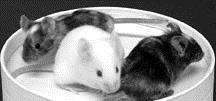Targeted-mutation mouse strains, created by homologous recombination in embryonic stem (ES) cell lines, have become a standard research tool for many fields of study. With an increased understanding of the effects of genetic background on phenotype1 and concerns about the time required to backcross strains to reach congenic status, there is an increased demand for gene targeting in pure inbred strains. Most targeted mutations have been generated using ES cell lines derived from 129 substrains. However, the trend is to increase the use of ES cell lines derived from other inbred strains, particularly C57BL/6 (B6)2.
C57BL/6 mice are the most commonly used inbred strain for many types of research. The genomic sequence of JAX® Mice strain C57BL/6J (Stock Number 000664) was determined in 20023. Several groups have reported the successful creation of ES cell lines from B6 mice2,4. The use of B6-derived ES cells can reach its maximum potential when coisogenic B6 mice are used at each stage of line generation. To this end, The Jackson Laboratory maintains an albino B6 strain, C57BL/6J-Tyrc-2J (Stock Number 000058). Homozygous C57BL/6J-Tyrc-2J mice are albino due to a spontaneous mutation of the tyrosinase gene (Tyrc-2J).

When B6-derived ES cells are injected into albino B6 blastocysts, chimeric mice are easily identified by their coat color (a mix of black and white patches); non-chimeric littermates are albino. Chimeric mice can then be mated to an albino (See Figure 1) B6 mouse to test for germline transmission of the targeted mutation.
Germline transmission is validated by the appearance of black offspring, while the lack of germline transmission is evident through the production of only albino progeny. One study indicates that the use of B6 albino blastocysts is more efficacious than the use of other albino inbred strains in the production of highly chimeric, germline-competent mice5.
The C57BL/6J-Tyrc-2J (Stock Number 000058) strain is available from the Laboratory. For more information, call 1.800.422.MICE (6423) or 207.288.5845, or visit our Web site: www.jax.org/jax-mice-and-services.
References
(Authors in bold are Jackson Laboratory scientists)
- Linder CC. The influence of genetic background on spontaneous and genetically engineered mouse models of complex diseases. Lab Anim 2001; 30:34-9.
- Lemckert FA, Sedgwick JD, Körner H. Gene targeting in C57BL/6 ES cells. Successful germ line transmission using recipient BALB/c blastocysts developmentally matured in vitro. Nuc Acids Res 1997; 25:917-918.
- Mouse Genome Sequencing Consortium. Initial sequencing and comparative analysis of the mouse genome. Nature 2002; 420:520-562.
- Ledermann B and Burki K. Establishment of a germ-line competent C57BL/6 embryonic stem cell line. Exp Cell Res 1991; 197:254-258.
- Schuster-Gossler K, Lee AW, Lerner CP, Parker HJ, Dyer VW, Scott VE, Gossler A, Conover JC. Use of coisogenic host blastocysts for efficient establishment of germline chimeras with C57BL/6J ES cell lines. BioTechniques 2001; 31:1022-1026.